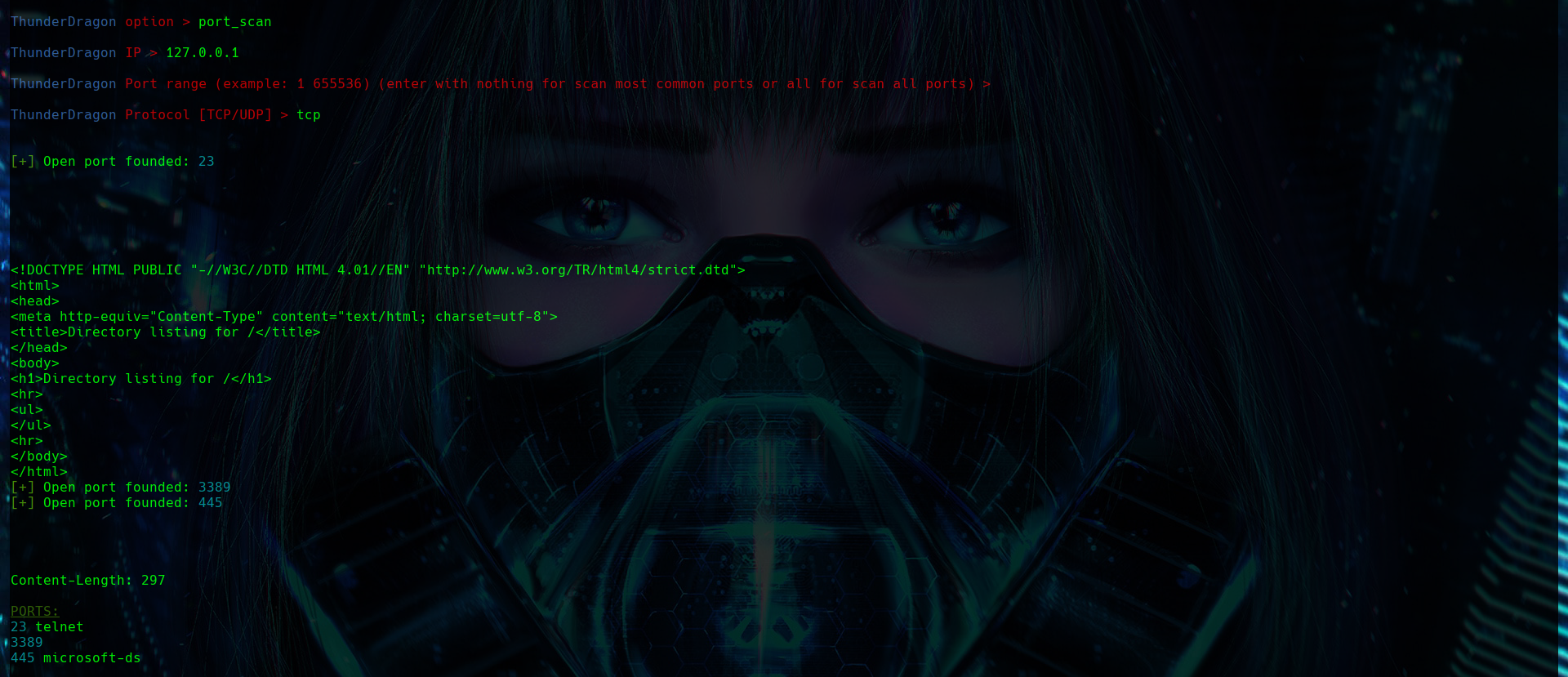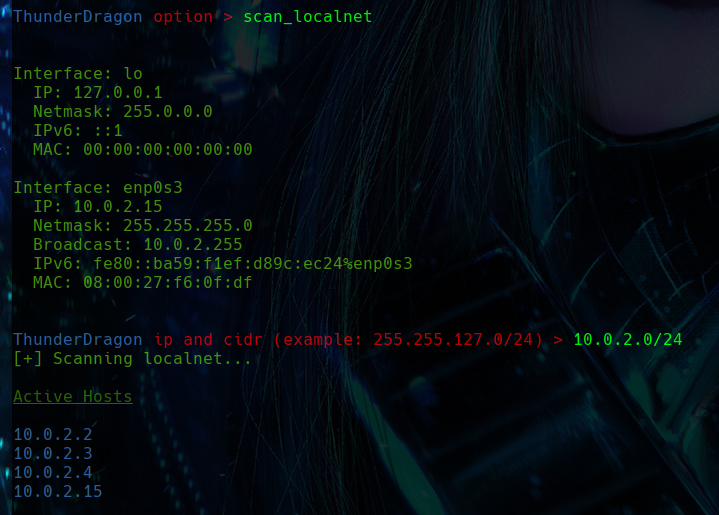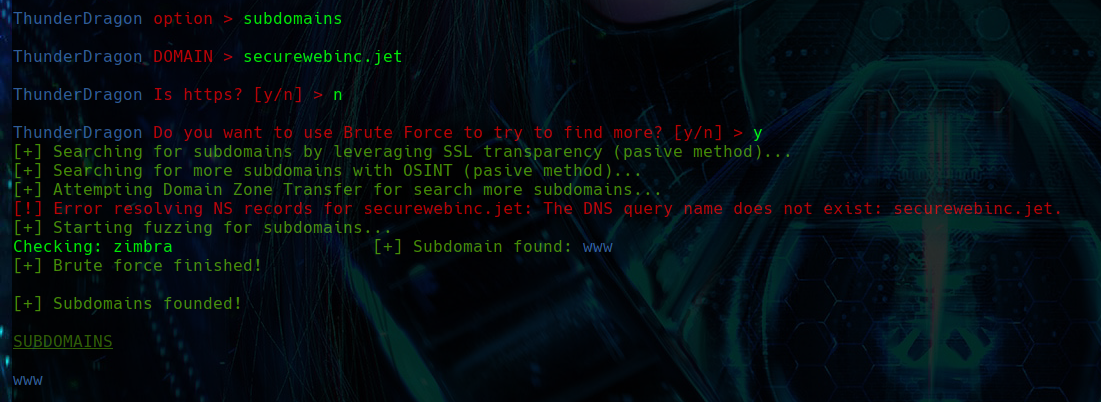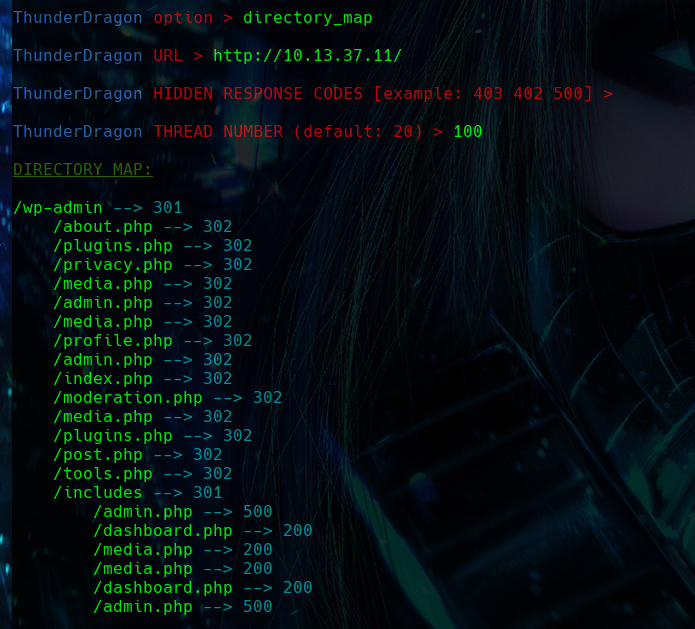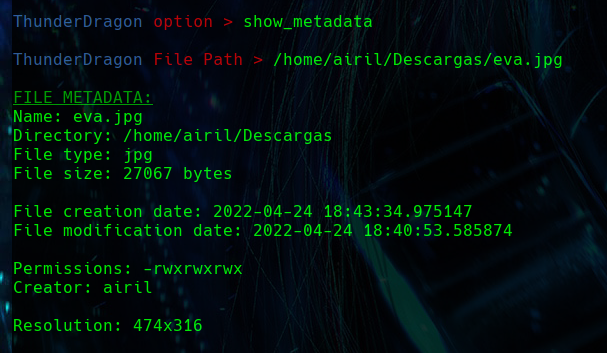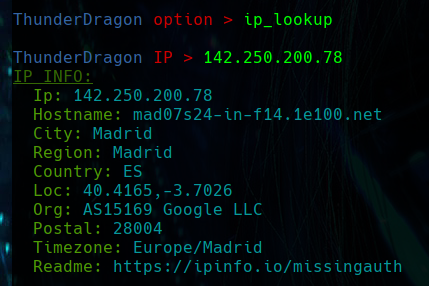Thunder Dragon

INDEX
- INTRODUCTION
- HOW TO USE
- ENUMERATION
- AUTOMATIC
- ATTACKS
- WIFI HACKING
- BLUETHOOD HACKING
- OTHER FUNCTIONS
INTRODUCTION
TOOL: https://github.com/AirilMusic/Pentesting-Hacking/tree/main/ThunderDragon
My goal with this tool is to simplify and automate the processes of enumeration, attacks, and other cybersecurity tasks, making them accessible and user-friendly for both seasoned professionals and novices alike. Designed to evolve gradually, this project is a long-term endeavor, and I appreciate your patience and understanding for any initial shortcomings or errors.
For enhanced accessibility, the tool supports both Linux and Windows platforms, although certain features might be Linux-exclusive. This dual-platform compatibility ensures the tool’s utility in a wide range of educational settings, from teaching basic pentesting and vulnerability assessment in computer science classes to demonstrating the critical importance of cybersecurity and risk management.
All designed with an intuitive user interface that streamlines complex tasks.
I do not take responsibility for the misuse that may be made of this tool.
HOW TO USE
Before starting to use this tool, we need to download it and install the requirements. To do this, we can download it manually and install the requirements found in requirements.txt using pip, or more quickly through the console in the following way:
Linux:
git clone https://github.com/AirilMusic/Pentesting-Hacking/tree/main/ThunderDragon
cd ThunderDragon
pip install -r requirements.txt
Windows:
git clone https://github.com/AirilMusic/Pentesting-Hacking/tree/main/ThunderDragon
cd ThunderDragon
pip install -r requirements.txt
pip3 install -r requirements.txt
And now we can run the tool:
python main.py
And now we can use the help command to see the options we can use (the image is just a reference, because over time I will be adding more options):

And from here, it would just be a matter of following the instructions provided by the tool.
ENUMERATION
- WHOIS
- PORT SCAN
- SCAN LOCALNET
- SUBDOMAINS
- FUZZING
- DIRECTORY MAP
- TEC ENUM
- WEBDAV ENUM
- SHOW METADATA
- IP LOOKUP
- CHECK CVE
WHOIS
The whois function is used to obtain and display detailed information about a specific domain. This information includes the domain name, the owner, the creation, expiration, and last update dates, the name servers, the domain status (DNS), associated email addresses, the owning organization, physical address, city, state, country, postal code, and contact phone number.
POR SCAN
The port_scan option is used to perform a port scan on a specific IP address. By selecting it, you can specify a range of ports to scan, but you can also specify that all ports be scanned with “all” or, if you have not specified anything, the most common ports will be scanned. To make the scan a little less noisy, fragment the packets and, instead of completing the connection by returning an ACK, close the connection by sending an RST (SYN –> SYN ACK –> RST instead of ACK).
SCAN LOCALNET
The scan_localnet function performs a scan of the local network to identify active devices, using an IP address and its CIDR notation as input. It operates by sending pings to each possible IP address within the specified range, logging those addresses that respond successfully as active hosts. To know the CIDR and the IP of the network, it first displays all the networks we have access to, so we can see the IP, network mask, etc.
As a quick guide to what CIDR is, here’s this table (although there are more possible CIDRs, this is quite general)
SUBDOMAINS
The functionality described is a multifaceted approach for discovering subdomains of a specified domain, incorporating both passive and active scanning techniques. Initially, it employs passive methods by exploiting SSL certificate transparency logs to uncover subdomains without actively querying the target domain. This is complemented by attempts at DNS zone transfers, where the tool queries the domain’s nameservers for a complete list of subdomains, a method that relies on potential misconfigurations in nameserver permissions.
For a more aggressive discovery, the tool performs brute-force attacks, generating subdomain names by combining a predefined list of potential names with the target domain and checking for their existence through HTTP(S) requests. This process is designed to identify active subdomains by evaluating the server’s response to these requests.
FUZZING
The functionality in question starts by passively identifying directories through a website’s robots.txt and sitemap.xml files, which often contain valuable information about the structure of the site. By parsing these files, the tool extracts directory paths that are explicitly listed, which can include both publicly accessible and restricted areas of the website. This passive method allows for the quick discovery of directories without sending numerous requests to the server, thus reducing the likelihood of detection.
Following this initial phase, the tool employs an active strategy, utilizing brute force to uncover additional directories. This involves systematically generating and testing potential directory paths against the website by appending entries from a predefined wordlist to the base URL and monitoring the server’s response to each request. Unlike the passive approach, brute-forcing aggressively probes the website for directories that might not be listed in robots.txt or sitemap.xml, potentially revealing hidden or overlooked paths. This combination of passive analysis and active probing provides a comprehensive overview of the website’s directory structure, offering insights into its organization and content.
DIRECTORY MAP
This option is similar to the previous one, however, what it does is that, upon finding a directory, it automatically analyzes whether there are more directories or files within it in a recursive manner, mapping the existing directories on the web through active fuzzing techniques. That is, testing directories and files via brute force and recursively.
TEC ENUM
The tec_enum option identifies the web technologies used and their respective versions. Once identified, it attempts to search for possible vulnerabilities and exploits for these technologies.
After identifying the technologies and their versions, it tries to find known vulnerabilities for the given technology and version, by querying the National Vulnerability Database (NVD). Then, for each vuln founded, it searches the same database for related “Common Vulnerabilities and Exposures” (CVEs) and limits the results to two for brevity. Additionally, it attempts to find proof of concept (PoCs) on GitHub for each identified CVE, as well as download links related to the technology on Packet Storm Security.
WEBDAV ENUM
The webdav_enum function is designed for enumerating WebDAV resources and methods at a given URL, with optional depth, username, and password parameters for authentication and search depth customization. Initially, it verifies available methods through an HTTP OPTIONS request; if ‘PROPFIND’ is allowed, it further sends a ‘PROPFIND’ request to list resources. The function gracefully handles and reports any errors encountered during these steps, highlighting both allowed methods and issues in fetching resources, ensuring users are well-informed about the server’s capabilities and any potential problems.
SHOW METADATA
The show_metadata function extracts and displays metadata for a specified file, including its name, directory, type, size, creation and modification dates, permissions, and creator information.
IP LOOKUP
The ip_lookup function retrieves and displays information about a given IP address, such as location, hostname, and ISP, by querying the “ipinfo.io” API and presenting the data in a user-friendly format.
CHECK CVE
First you have to set the tecnologie and it’s version, and then it tries to find known vulnerabilities for the given technology and version, by querying the National Vulnerability Database (NVD). Then, for each vuln founded, it searches the same database for related “Common Vulnerabilities and Exposures” (CVEs) and limits the results to two for brevity. Additionally, it attempts to find proof of concept (PoCs) on GitHub for each identified CVE, as well as download links related to the technology on Packet Storm Security.
AUTOMATIC
AUTO RECOGNITION
The auto_recognition option performs automatic and customized recognition of a machine. My intention in the future is to incorporate the ability to create preset configurations to carry out these scans more quickly and conveniently.

ATTACKS
SHELL SHOCK
The Shellshock vulnerability occurs in the Bash command interpreter, which is used by many Unix and Linux operating systems to execute shell scripts. The problem lies in the way Bash handles environment variables. Attackers can inject malicious code into these environment variables, which Bash executes without questioning their origin or content.
Attackers can exploit this vulnerability through different attack vectors. One of them is through the User-Agent. Attackers can manipulate the User-Agent to include malicious commands, which the web server will execute upon receiving the request.
This is normally done when a /cgi-bin directory is found and can work when the version of Bash is old.

